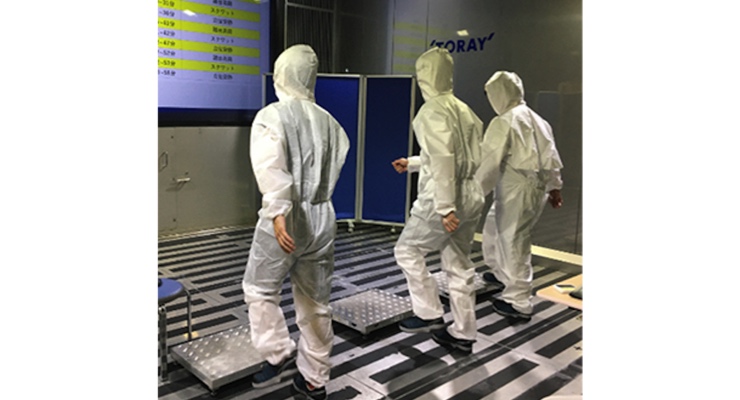09.19.23
Toray Industries announced that it has added two items to its Livmoa series of comfortable, single-use protective clothing. One is the Livmoa 4300AS, a water- and oil-resistant model that offers excellent breathability. The other is the Livmoa 1000AS, an entry-level model that complies with the JIS T 8115:2015 Type 5 (sealed for protection from solid airborne particulates) and JIS T 8115:2015 Type 6 (sealed for protection from mist) standards.
The Livmoa 4300AS model employs spunbond nonwoven fabric laminated with breathable film on a spunbond fabric on the exterior to control oil penetration. The hood and upper back employ SMS (spunbond + dense, water-resistant meltblown + spunbond) nonwoven fabric. This fabric also features on the Livmoa 4000AS, which offers excellent water resistance, dust protection, and breathability.
Toray based the specifications for combining these two fabrics on outcomes from trials at steelmakers and other manufacturers, etc., positioning breathable nonwoven fabrics where oil stains are unlikely, thereby overcoming the challenges of preventing oil stains and ensuring air permeability. Toray designed the Livmoa 4300AS for use in manufacturing, maintenance and painting sectors in which oil stains are pervasive.
The Livmoa 1000AS is an entry-level model delivering affordable comfort. Toray based it on the Livmoa protective clothing design concept of contributing to comfortable and safe work environments for all by factoring in extreme heat conditions in Japan during the summer and the particular features of Japanese worksites.
As mentioned earlier, this offering complies with JIS T 8115:2015 Type 5 (sealed for protection from solid airborne particulates) and JIS T 8115:2015 Type 6 (sealed for protection from mist). It delivers moderate breathability and water resistance. It is also worth noting that the design reflects feedback from Livmoa series customers. It incorporates elastic to prevent sleeves from rolling up. The design around the crotch that makes it easier to spread the legs. Among the many applications for this model are removing asbestos, spraying urethane, maintenance, general manufacturing and dusty and dirty work.
The breathability of Toray’s fabric reduces humidity inside garments and suppresses perspiration, helping to alleviate discomfort in working in hot areas and prevent heat stroke. Depending on the type of protective clothing worn, such as that made of non-breathable materials, the Wet Bulb Globe Temperature (WBGT) index values measured at work sites should be added to clothing correction values in the table below.
Regular protective clothing materials are often in the nonwoven polyolefin coveralls as a single layer, with clothing adjustment values of +2°C. Livmoa is in the nonwoven SMS coveralls as a single layer, with clothing adjustment values of 0°C that makes it suitable for working in hot environments.(Excluding Livmoa 4300AS)
Since debuting the Livmoa series in 2017, Toray has broadened the lineup to cater to diverse applications, including dust protection, infection control and cleanrooms. One of the four goals of the Toray Group Sustainability Vision for 2050 is to contribute to a world in in which everyone enjoys good health and hygiene. The company will keep developing offerings that combine comfort and functionality for various needs.
The Livmoa 4300AS model employs spunbond nonwoven fabric laminated with breathable film on a spunbond fabric on the exterior to control oil penetration. The hood and upper back employ SMS (spunbond + dense, water-resistant meltblown + spunbond) nonwoven fabric. This fabric also features on the Livmoa 4000AS, which offers excellent water resistance, dust protection, and breathability.
Toray based the specifications for combining these two fabrics on outcomes from trials at steelmakers and other manufacturers, etc., positioning breathable nonwoven fabrics where oil stains are unlikely, thereby overcoming the challenges of preventing oil stains and ensuring air permeability. Toray designed the Livmoa 4300AS for use in manufacturing, maintenance and painting sectors in which oil stains are pervasive.
The Livmoa 1000AS is an entry-level model delivering affordable comfort. Toray based it on the Livmoa protective clothing design concept of contributing to comfortable and safe work environments for all by factoring in extreme heat conditions in Japan during the summer and the particular features of Japanese worksites.
As mentioned earlier, this offering complies with JIS T 8115:2015 Type 5 (sealed for protection from solid airborne particulates) and JIS T 8115:2015 Type 6 (sealed for protection from mist). It delivers moderate breathability and water resistance. It is also worth noting that the design reflects feedback from Livmoa series customers. It incorporates elastic to prevent sleeves from rolling up. The design around the crotch that makes it easier to spread the legs. Among the many applications for this model are removing asbestos, spraying urethane, maintenance, general manufacturing and dusty and dirty work.
The breathability of Toray’s fabric reduces humidity inside garments and suppresses perspiration, helping to alleviate discomfort in working in hot areas and prevent heat stroke. Depending on the type of protective clothing worn, such as that made of non-breathable materials, the Wet Bulb Globe Temperature (WBGT) index values measured at work sites should be added to clothing correction values in the table below.
Regular protective clothing materials are often in the nonwoven polyolefin coveralls as a single layer, with clothing adjustment values of +2°C. Livmoa is in the nonwoven SMS coveralls as a single layer, with clothing adjustment values of 0°C that makes it suitable for working in hot environments.(Excluding Livmoa 4300AS)
Since debuting the Livmoa series in 2017, Toray has broadened the lineup to cater to diverse applications, including dust protection, infection control and cleanrooms. One of the four goals of the Toray Group Sustainability Vision for 2050 is to contribute to a world in in which everyone enjoys good health and hygiene. The company will keep developing offerings that combine comfort and functionality for various needs.


